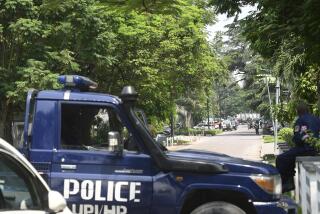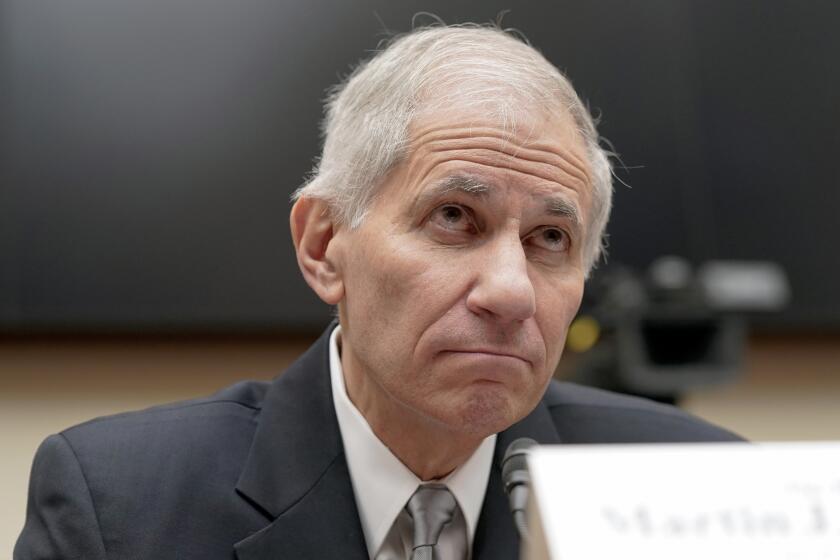Please Don’t Feed the Extremists : In the conflict between animal rights activists and scientists, the middle ground is where both animal and human lives matter : THE MONKEY WARS, <i> By Deborah Blum (Oxford University Press: $25; 306 pp.)</i>
While surgeons in Pittsburgh were transplanting the liver of a baboon into a man’s body, animal activists at the hospital entrance were chanting, “Animals are no spare parts.”
Their protest was interrupted by Robert Winters, a patient on his way to a hepatitis treatment. Hepatitis attacks and destroys the liver. Starting up the steps, Winters shouted: “I didn’t ask for this! But I’ve got it and I’m fighting it just like that guy (getting a transplant) up there! You don’t have a right to be standing here!” The chanting stopped as Winters went on. “Do you know what it’s like to have liver disease? Do you?”
The ethics of sacrificing a monkey for a human life are complex enough, but there was more. Regardless of how well that transplant might have worked out, the patient with the baboon liver was not expected to live long. He had AIDS. So it was not just a monkey’s life for a person with a great future, but for an incurably ill person. Once the activists learned of this situation, they returned angrier than before.
What makes dilemmas like these particularly difficult is the value most people intuitively attach to the lives of monkeys and apes, our closest animal relatives. Confronted with creatures so strikingly like us, it is not hard to imagine that they have emotions similar to ours, that they are able to suffer and feel miserable as we do. There is increasing evidence that they are intellectually closer to us than any other animal. They think and plan and solve problems with a speed that often astonishes people working with them. Add to this the endangered status of many primates in the wild, and we have every reason to assign greater weight to their lives than to that of more common laboratory animals, such as rats or mice.
Unfortunately for the primates involved, their similarity to us also carries weight from a medical perspective: It makes them uniquely valuable for transplants and research. They are often the only animals susceptible to diseases that affect us. If it were not for the testing of the polio vaccine on hundreds of thousands of monkeys in the 1950s and 1960s, science might never have halted this crippling disease. The now widely used vaccine against hepatitis B was developed largely on chimpanzees. And most scientists believe that there will be no vaccine against AIDS without primate research.
On the one hand, then, we are dealing with magnificent, intelligent animals that clearly deserve our respect and concern. On the other hand, they may hold the key to medical mysteries the resolution of which could save millions of human lives. With stakes so high, small wonder that the use of monkeys and apes in biomedical research has become one of the hottest controversies of today.
In “The Monkey Wars,” Deborah Blum provides a candid look at the issues from both sides. No comparable book on this topic exists, and after reading it it is not hard to understand why there is so much polarization. Blum reports the tactics of animal advocates, ranging from protest demonstrations and legislative initiatives to personal death threats, arson and laboratory break-ins. One group, the Animal Liberation Front, is violent enough to be on the FBI’s terrorist list. On the other side, she describes in gruesome detail historical research by a few bad-apple scientists that have done great harm to their profession. However, she also visits the labs of first-rate investigators who explain how they go about minimizing pain and suffering and why their work should matter to the world.
Blum, a science writer for the Sacramento Bee, received a Pulitzer Prize for an earlier series of newspaper articles on the same subject. Based on visits to the most important facilities and in-depth interviews with key participants, she is generally extremely well-informed. Both sides no doubt view her account as biased against them, which will only go to show how balanced it really is.
While enumerating various medical triumphs, Blum does not hide her shock at certain conditions and practices. She sympathizes with animal advocates who take issue with the way animals are being treated without giving them so much as a finger on the one thing many of them would like to see, that animal research be abolished altogether. Blum succeeds admirably at sharing their concerns without losing sight of what is at stake for society. After all, anyone entering a hospital or picking up a prescription at the pharmacy makes use of animal testing.
Realizing that the way we look at such research is not the same as it was 20, or even 10 years ago, Blum follows a middle course culminating in a plea for a more enlightened treatment of animals in our care and for open debate instead of the continued hostility.
Blum’s interviews demonstrate how intensely personal many of these issues have become. She describes Alex Pacheco of PETA (People for the Ethical Treatment of Animals) as a passionate animal defender, yet also relates his unwillingness to allow veterinarians to euthanize a monkey, thus prolonging the animal’s misery. Apparently, moral obligation took a back seat to political expediency. Pacheco’s chief adversary, Peter Gerone, director of the Tulane Regional Primate Research Center, on the other hand, is depicted as an indefatigable champion of research, who says about the animals he works with: “I don’t relate to monkeys and I don’t want to. It would bias my ability to direct a center that does research on them.”
The nasty battle between Pacheco and Gerone over the fate of the Silver Spring monkeys--removed, in 1981, from a Maryland laboratory--has set the tone of confrontations between animal advocates and researchers ever since.
Blum provides us with thumb-nail sketches of these and other players. There is plenty of personal drama, including scientists who claim that their career went down the drain because of their sympathy for animals, and administrators who have managed to build up cozy relationships with animal advocates. One of the most interesting sections deals with Harry Harlow, whose early work on monkeys reared in isolation was critical for our understanding of the affection needs of primates. Harlow subsequently went overboard, however, designing one experiment after another to see how best to thwart these needs. William Mason, one of Harlow’s ex-collaborators, distances himself in unmistakable terms from this later research.
Harlow’s ghost may still be with us, but he is not here anymore to defend himself. In this day and age, it is unlikely that his experimental protocols would be approved. They would meet with resistance not only from the outside but also from inside the research community. An entire generation of scientists has grown up with increased awareness of the special responsibility that we as a species have toward other species. They are not convinced of having a God-given right to do whatever pleases them. As Blum explains, the research community is not a monolithic block; many different voices can be heard, including those that argue for radically different ways of conducting science.
Primate research facilities have adopted strict guidelines for research, and are moving from keeping their animals singly in stainless steel cages to housing them in groups in spacious enclosures or outdoor compounds. Some research centers now keep the majority of their animals in this fashion. I was naturally pleased to see my own institution, the Field Station of the Yerkes Regional Primate Research Center in Atlanta, Ga., singled out as a model to be emulated. The philosophy behind this facility, as well as a few others that successfully combine social housing and biomedical research, is that in the end everyone gains from psychologically healthy animals. Primates evolved as social beings; there is no better and more natural way to enrich their lives than providing them with companionship. At the same time, making their existence more variable and satisfying may make them more suitable research subjects.
Blum urges animal advocates to step back a little from the fences around research facilities so as to appreciate the genuine progress made by some. Looking beyond the positions of the most radical animal advocates and the most conservative defenders of scientific freedom, we can see an entire middle ground out there. It is not a place for simple slogans, nor for neat boxes marked “right” and “wrong,” but one where the large majority of people will feel a lot more comfortable than on the barricades erected over the past decade. It is a place where both animal and human lives count, and where we can honestly and calmly ponder the so-called pain/gain equation, that is, how much pain we are prepared to inflict for scientific gain.
“The Monkey Wars” documents the shifting of this balance. It argues that the time has come to close our ears to the yelling proponents of the most extreme positions and tune in to voices of reason and moderation. As in the Middle East, not everyone may be happy with dialogue, but it has to be tried if we ever wish to get beyond the current standoff.
More to Read
Start your day right
Sign up for Essential California for news, features and recommendations from the L.A. Times and beyond in your inbox six days a week.
You may occasionally receive promotional content from the Los Angeles Times.






